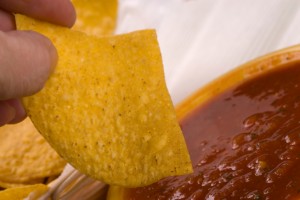 An article published this week points to increased snacking as a key factor in our obesity epidemic, even more so than our lack of portion control. According to a new study, the number of meals and snacks consumed daily is the largest single contributor to the dramatic growth in calorie intake over the past 30 years. The study found that Americans now consume an average of 4.9 meals and/or snacks a day, compared to 3.8 in 1970, which is an increase of a startling 29 percent. The article points out that while portion sizes have increased in this time frame as well, they only increased an average of 12 percent.
An article published this week points to increased snacking as a key factor in our obesity epidemic, even more so than our lack of portion control. According to a new study, the number of meals and snacks consumed daily is the largest single contributor to the dramatic growth in calorie intake over the past 30 years. The study found that Americans now consume an average of 4.9 meals and/or snacks a day, compared to 3.8 in 1970, which is an increase of a startling 29 percent. The article points out that while portion sizes have increased in this time frame as well, they only increased an average of 12 percent.
Barry Popkin, who is a professor of nutrition at the University of North Carolina at Chapel Hill, blames food advertising for the move from three square meals a day to near-constant grazing, saying “It’s all about making people think they want to have something in their hands all the time. Food is there, it’s available all the time, it’s tasty. It’s not very healthy, but it’s tasty. It’s sweet, it’s salty, it’s fatty — it’s all the things we love.”
The researchers studied data from four nationally representative food surveys conducted by the U.S. Department of Agriculture and the Centers for Disease Control and Prevention from 1977 to 2006. The findings and analysis are published in the June issue of the journal PLoS Medicine, an peer-reviewed open access journal published by the Public Library of Science.
Dr Thomas Brown explains, “this study validates what we’ve suspected for a long time. Average American adults are gaining weight because they are consuming more calories due to habitual snacking and grazing. The study points out that about 30% more calories/day are being consumed today compared to 30 years ago and is largely attributed to increased numbers of meals and snacks, including calorie dense coffee beverages and sodas that some people drink all day long. The single most important life style change that we encourage patients to do at the Colorado Bariatric Surgery Institute to do is to stick to only 3 meals and one snack per day.”
Dr. Brown says that for anyone, “It’s important to focus on label-reading, so that people are keenly aware of the calories they are ingesting each day. Portion sizes have also increased over the years and this is evident in pre packaged and convenience foods. It can be confusing to recognize that there may be several servings in a single packaged product unless you read the labels. Heightening awareness to snacking and portion size can help prevent consumption of hundreds of empty calories each day,” he concluded.






Nutrition & Lifestyle